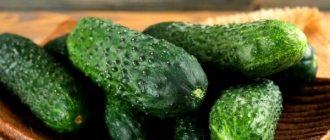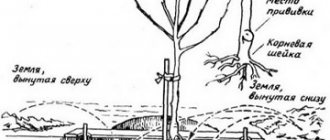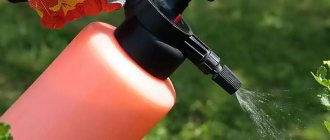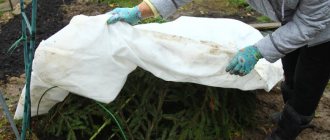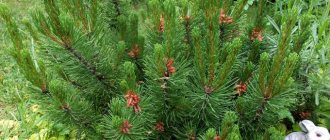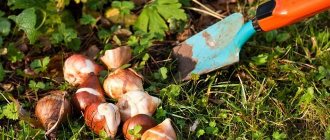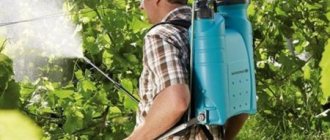An experienced gardener does not give up caring for plants all year round. Every month there are priority tasks that will help you regularly get a rich gooseberry harvest. A care calendar will help you plan your work and set tasks.
Gooseberry is a durable and unpretentious berry bush; it maintains productivity for at least 15 years, and in favorable conditions and with good care - up to 30-40 years. Gooseberries can withstand relatively low soil acidity (up to pH 5.5). It is more resistant to drought compared to other berry plants, but with a long absence of watering (up to 2 months) it sheds its leaves, does not form flower buds, and the berries become smaller.
The shrub is quite frost-resistant, annual growth freezes at a temperature of –33-34°C, but the roots of young bushes can freeze at –3-4°C in snowless winters. Gooseberries bear fruit on perennial fruit formations; 4-6 year old shoots are most productive. The shoots of rose hips of most varieties are lined with thorns. Modern varieties are selected, among other things, for their thornlessness. Gooseberries of the Vladil, Candy, Rozovy 2, Northern Captain, Senator, and Serenada varieties are distinguished by a small number of weak thorns or their complete absence.
You can regularly get a good gooseberry harvest if you know its biological characteristics, requirements for agricultural technology and take this into account. Check our calendar when planning your gooseberry care work for the month.
January
Rake snow from paths and distribute under bushes
In winter, the orchard is dormant and sleeps under a blanket of snow, but there is always work for an experienced gardener. The main concerns are related to snow retention; this is especially true in light-snowy, “black” winters, when thaws can give way to sharp cold snaps.
Reliable protection of the roots from frost is provided by a layer of snow 12-15 cm high. If there is not enough snow under the bushes, rake it off the paths and distribute it in the area where the roots are located. You can cover the bushes with snow, but do not expose the roots. This measure will protect the shoots from severe frosts.
March
Regulate melt water flow
The time for thaws and melt waters is coming. If your site is located on a slope, make banks of snow to retain water that can wash away the fertile layer of soil. In low-lying areas where there is a risk of flooding, be sure to clean the grooves for drainage and drainage of water. This will help avoid stagnation in the root zone. Berry bushes, including gooseberries, do not tolerate prolonged waterlogging.
At the end of the month, if the condition of the site allows and the snow has already melted, you can begin pruning the bushes. Its goal is to form a light bush without thickening, with strong shoots of different ages. Early-growing gooseberry varieties with strong branching and numerous shoots form a bush in 2-3 years. The pruning plan depends on the age and condition of the bush. Trim the shoots of young seedlings, leaving 4-5 buds, remove weak and dried branches. On 2-3 year old bushes, leave about 3-5 well-developed, well-placed shoots. On older (3-4 years) bushes, leave 10-12 branches of different ages, including several annual ones. Mature fruiting bushes can have about 20 branches of different ages.
Trim and shape gooseberry bushes
Gooseberries form their main harvest on last year's growths and 2-3-year-old fruits, so it is recommended to remove branches older than 5 years. Thin out the crown, avoiding thickening, cut out old branches from the middle of the bush. In a thickened gooseberry bush, diseases arise more quickly, shoots and buds ripen worse, which weakens the winter hardiness of the plant. Be sure to remove shoots with traces of last year's powdery mildew (felt coating with black dots).
For bushes with weak branching and a small number of shoots, remove weak, lodging and damaged shoots.
Before the buds open, treat the gooseberry bushes with preparations against the wintering stages of pests (leaf rollers, aphids, scale insects, mites). The drug Profilaktin is suitable for early spring treatment; use it at an air temperature of at least 4°C.
Treat bushes against wintering pests
Spring pruning of gooseberries: sanitary and formative
Pruning is a fundamental activity that directly affects gooseberry yield . This fast-growing crop is prone to overgrowth. Fresh young shoots grow very actively, forming dense, impenetrable thorny thickets of intertwined branches.
On neglected bushes there are few berries and they are small
In poorly ventilated, dense bushes, fungal infections often progress and all kinds of harmful insects live. Few ovaries are formed, since pollination is difficult. An overgrown bush bears fruit poorly, the berries are small and sour in taste, since the sun's rays do not penetrate inside the bush. Gradually, fruiting stops completely.
Excess thickening branches must be removed
Spring pruning is considered sanitary, since the main pruning of gooseberries is most often carried out in the fall. In early spring, in the first ten days of March, they cut out:
- dried, frozen and partially frozen branches in winter (down to living tissue);
- shoots damaged by fungal diseases or insect pests;
- weak, thin and twisted branches;
- shoots growing inside the bush, rubbing against each other and crossing;
- branches located too close to the ground or lying on it.
Gooseberries must be pruned before sap begins to flow.
Regular formative pruning is carried out as follows:
- When planting a seedling in open ground, no more than 3-4 of the strongest and thickest shoots are left on it, which are located in the space in the right way. About 4–5 buds are left on each of them. Everything else is deleted.
- The next year, choose 5-6 powerful and well-oriented branches, shorten them by a third to stimulate branching. Weaker ones, those facing inward or strongly inclined towards the ground surface, as well as curved and diseased ones are cut out.
- In the third year, when the first berries appear, no more than 4–5 strong shoots are again left, cutting out all that is unnecessary. The current season's shoots are cut to a third of their length.
- In the fourth year of life, a few successful and strong branches are again left, removing what is unnecessary. The bush at this time should have about 18–20 shoots of different ages (from 1 to 4 years), its crown is considered formed.
- Starting from the fifth year, light anti-aging pruning is carried out.
The formation of the gooseberry crown takes place over four years.
The cut must be made above the bud located on the outer part of the stem. It is important not to damage the flower bud. 5–6 mm are removed from the eye and cut at an angle of 45–50°. If you cut a branch lower, the developing bud will not have enough nutrition and it will dry out. A cut made above can lead to drying out first of the part of the stem above the bud, and then of the entire branch.
In spring, there is usually always little time and it is difficult to get everything done in the garden on time, so I try to prune berry bushes in the fall. In mid-March I only remove branches that have broken under the snow or are frozen out.
Video: features of spring pruning gooseberries
April
Plant gooseberry seedlings
In the earliest possible time, before the buds begin to bloom, you can still have time to plant gooseberry seedlings if you were unable to do this in the fall. For berry bushes in the middle zone, planting in the fall is most favorable, but, as a last resort, you can do this in early spring.
Fill the planting site with fertilizers - 4-5 kg of humus or compost, 50-80 g of superphosphate, 30-40 g of ammonium nitrate, 20-30 g of potassium sulfate or 100-120 g of complex mineral fertilizer. You can add ash and, if necessary (on acidic soils), lime materials. Dig up the soil with fertilizers to a depth of 20-25 cm, dig a hole 30-40 cm deep and about 50 cm wide. At the same time, set the top fertile layer of soil aside, and then place it at the bottom of the hole, filling it about 3/4 full.
Before planting, inspect the roots, trim the dried roots and place the seedling in water for 2-3 hours. If the root system is weak, treat the plant with any root formation stimulator, according to the instructions (add the drug to the water or sprinkle the roots with powder). When planting, deepen the bush by 6-8 cm, this stimulates the growth of additional roots and shoots. Fill the space between the roots with soil, water (5-10 liters of water per bush) and mulch the surface with peat and sawdust to retain moisture. Trim the seedling, leaving 4-5 buds on each shoot.
Feed adult gooseberry bushes, use nitrogen fertilizers (2/3 of the annual norm) or special mineral complexes for spring feeding of fruit and berry crops. Urea, which is easily accessible to plants, dissolves well in water and is convenient to apply in liquid form (40-50 g per 1 bush). Make a furrow about 10 cm deep around the bush, pour it with a fertilizer solution, and cover it with soil.
It is convenient to apply urea for fertilizing in liquid form.
Heat brings to life numerous pests. If last season the gooseberries were severely damaged by aphids, scale insects, leaf rollers or other insects, it is time to spray the plants with approved insecticides (Fufanon-Nova). For minor damage, you can use herbal infusions (tobacco, mustard, garlic, onion peels). Spray the bushes in cloudy, windless weather or in the evening.
Caring for gooseberries after winter
In early spring, the bush comes to life after a long “winter hibernation”. When the snow has completely melted in the tree trunk area, it is necessary to remove the shelters from the bushes to avoid damping off. To prevent the plant from experiencing stress, remove the cover gradually. One day, remove part of the covering material, and after a couple of days, remove the rest of the covering.
At the end of April, when the surface layer of soil warms up, you can begin cleaning around the bushes. First of all, clear the soil under the bushes of old leaves and mulch, and then loosen the soil with a hiller or rake to a depth of no more than 6 cm. Clear of weeds.
Pests of berry crops often make their refuge in plant debris. Therefore, it is recommended to take the collected leaves and mulch outside the site.
Cleaning the shelter
The shrub is sheltered for the winter in the northern regions of our country, where winters are harsh. There the branches are pressed to the ground, peat, straw, and leaves are thrown over them. Afterwards, to preserve heat, the formed mound is wrapped in spunbond. Ordinary film and roofing felt are also used. In the middle zone, pre-winter preparation consists of covering the ground under the bush with mulch (hay, grass, fallen leaves, bark).
May
If there is a threat of frost, protect flowering gooseberry bushes
Gooseberries bloom early, when frosts are quite possible. Flowers can be damaged at a temperature of –2°C, young ovaries – at –1.5°C. Shrubs are more susceptible to freezing than trees, because... The temperature at the soil surface may be lower than at the crown level. If you have a large gooseberry plantation, then if there is a threat of frost, you can arrange fine spray irrigation, water the bushes and the soil under them. It is easy to cover single bushes with non-woven material, paper or film. Isolate the flowers from contact with plastic film by arranging a frame.
If you find pests on gooseberry bushes, estimate their number. When aphids appear, it is enough to dip the shoots with aphid colonies in a soap solution or infusion of tobacco or garlic. In case of serious pest proliferation, you will have to use approved insecticides; in case of minor damage, it is better to repel them with herbal decoctions and infusions.
It's time to propagate your favorite gooseberry bush with horizontal layering. Loosen and water the soil around the bush. Make grooves 5-7 cm deep, bend the selected 2-3-year-old shoots and bend them, pinning them to the ground. Water and sprinkle with compost, peat or loose soil. Later, water and hill up the young shoots growing from the buds so that they develop additional roots. Increase the soil layer to 15 cm. By autumn, with good care, good roots will form at the base of the sprinkled shoots. Remember that the bush that you are planning to propagate must be healthy and productive, without signs of disease or pest damage.
June
Weed and water gooseberry bushes
Weed around the bushes and mulch the soil to retain moisture.
Water when hot and dry weather occurs. You need to water not in small portions, but spending 20-30 liters of water per bush.
At the beginning of the month, combine watering with fertilizing with complex mineral fertilizers, available organic or organomineral mixtures.
Take care of the rooting horizontal layers of gooseberries, hill them up or mulch them with loose material, water them if necessary and feed them with nitrogen fertilizer. Before fertilizing, be sure to water the soil, then cover it with soil.
At the end of the month, start propagating gooseberries using green cuttings. Lignified cuttings of this crop take root with difficulty. It is easiest to propagate varieties with a large number of young shoots (Kolobok, Northern Captain, Smena). Cut cuttings 5-7 cm long with a razor or sharp knife, treat the lower ends in a root formation stimulator. Plant the cuttings in a nursery with light, loose soil to a depth of 2 cm. Cover the plantings with film on the frame, regularly moisten the air under the cover with a fine spray.
With the onset of wet and cool weather, there is a danger of the development of American powdery mildew (spharotheca) on gooseberry bushes. For prevention, use folk remedies - a whey solution (1 liter per 9 liters of water) or an infusion of rotted hay. It is convenient to use ready-made preparations based on Bacillus subtilis - Fitosporin-M and others.
Preventively treat gooseberries against American powdery mildew. Photo by the author
If you notice large and prematurely colored berries among the green gooseberry ovaries, be sure to collect and destroy them, they are affected by the caterpillars of the gooseberry moth.
Reproduction methods
The most accessible ways to propagate gooseberries are:
- Reproduction by jigging
- Lignified cuttings.
The Donetsk large-fruited and Date varieties do not root well with lignified cuttings, so it is more effective to propagate gooseberries of these varieties with green cuttings. They are rooted using a small greenhouse or even under a glass jar.
Cuttings are cut 10–12 centimeters long in late May–early June from the current year’s growth and immediately planted in moist soil, leaving 2–3 top leaves on the shoot. Further care will consist of frequent watering and shading from direct sunlight. Then the coverings are removed and the gooseberries are fed with fast-acting fertilizers.
July
It's time to harvest. Photo by the author
The most pleasant time is the time of harvesting gooseberries. Prepare a convenient small container; try not to pour the berries from one container to another. Collect the gooseberries from which you are going to make jam without waiting for complete ripeness. For fresh use, it is better to take fully ripe berries that have the characteristic color and taste inherent in the variety. Pick berries in dry weather, in which case they can be stored in the refrigerator for up to 10 days.
Photo by the author
Do not forget that at the same time as the gooseberry bears fruit, fruit buds are formed, guaranteeing next year’s harvest. Continue to care for the bushes: water, destroy weeds, loosen and mulch the soil.
After harvesting, feed the bushes with complete mineral fertilizer; you can use mixtures in which phosphorus predominates and microelements are added. For feeding, it is convenient to dissolve fertilizers in water (1 tablespoon per 10 liters of water).
Photo by the author
Feed the rooted cuttings, use liquid fertilizers with organomineral mixtures, or make a mixture of 15 g of urea, 50 g of superphosphate and 15 g of potassium salt per 10 liters of water.
August
Treat gooseberry bushes against diseases and pests
After complete harvesting, be sure to inspect the gooseberry bushes and find out how affected they are by diseases and pests. Depending on the degree of damage, treat with chemical or biological preparations, you can use herbal infusions. Remove weak, dried out, diseased shoots.
Continue to care for rooting horizontal layering and green cuttings. Feed them a second time, hill up and water the cuttings.
Destroy weeds on which pests can settle, and water the bushes in dry weather.
September
Prepare holes for planting new gooseberry bushes
Start preparing for planting new gooseberry bushes, prepare the holes 2-3 weeks before the intended planting so that the soil has time to settle. Fill the holes with loose, fertile soil and fertilizer.
At the end of the month, a root lobe usually forms on horizontal layering. Dig up the soil in the rooting areas and use pruning shears to separate the cuttings from the mother plant. Most often, young shoots and roots are formed from each bud. Cut the cuttings into pieces according to the number of young shoots with roots. Plant well-developed specimens with roots 15-20 cm long in a prepared place; leave weak seedlings in a separate bed for growing over the next year.
Plant plants at a distance of 20-25 cm from each other and 70-80 cm between rows. Place the seedlings at an angle, slightly deeper. Trim the shoots, leaving 2-3 buds. Water and mulch the plantings with compost or peat. If you are growing several varieties in one bed, do not forget to attach labels to the seedlings and make a planting plan.
Landing
A high yield largely depends on the first stage. The crop is planted in spring or autumn, selecting healthy planting material (one-year or two-year-olds).
On a note! Most summer residents prefer autumn planting. With this approach, plants take root and develop better.
When selecting bushes, take into account:
- no mechanical damage;
- length and number of skeletal roots (at least three with a length of 20-23 cm);
- number of ground shoots (2-3 pieces 25-35 cm high).
It is better to take seedlings with a closed root system with leaves, while those with an open root system should be without them.
Approximate landing times
| Season | Deadlines |
| Spring | Before the start of sap flow. In the south - March; in the middle zone, regions of the North-West - April |
| Autumn | From mid-September, throughout the first half of October. About 25-30 days before the onset of cold weather |
The dates are approximate, since the exact time depends on the climate of the area and the weather conditions of a particular season. If early frosts are expected in the fall, it is recommended to postpone planting to spring.
Loose, fertile soils are chosen for the crop. Acidity indicators are neutral or slightly acidic. Gooseberries prefer places well lit by the sun, without close groundwater. Low-lying, damp areas are excluded; the plant does not tolerate waterlogging. The best predecessors: potatoes, beets, peas.
The site is prepared a month before autumn planting: weeds are removed, the soil is dug, and holes are made. Approximate depth - half a meter, width - 50-60 cm. Fertilizers are applied:
- humus;
- superphosphate;
- wood ash.
The seedlings are placed in holes, deepened by about 3-5 cm at the root collar. Sprinkle with soil, compact, water and mulch (peat, humus). If the weather is dry, the bushes are watered (every 6-8 days).
When planting in spring, the site is prepared in the fall. They dig up and apply fertilizer. Before sap flow begins and buds swell, young plants are planted. The shoots are cut to approximately 15-25 cm, leaving up to 4 buds on the plant.
October
Inspect the bushes and carry out sanitary pruning. Photo by the author
Finish planting the gooseberry seedlings. When purchasing from a nursery or garden center, carefully inspect the bushes, paying special attention to the integrity of the shoots and the condition of the roots.
Plants should not be dried out, without leaves, with well-formed unblown buds and an extensive root system. According to existing standards, annual seedlings should have one shoot with a diameter of 0.6-0.8 cm, and biennials should have at least 2-3 shoots (depending on the commercial grade) with a diameter of 0.8-1 cm. Length of shoots of first-class seedlings - at least 30 cm, for seedlings of the second grade - at least 25 cm. The length of the roots for seedlings of the first grade is at least 20 cm, for the second grade - at least 15 cm.
Before planting purchased seedlings, cut off the dried roots and soak the root system in water for 2-3 hours; you can add a root formation stimulator to the water. Sprinkle the seedlings with loose soil; it should fill all the space between the roots. Do not press down the soil too much; it is better to water the plantings and, if necessary, add soil or mulching material.
Inspect old gooseberry bushes, carry out sanitary pruning, remove broken and diseased shoots.
How to plant gooseberries
Planting gooseberries is not very difficult. Gardeners who have already grown this plant will cope with this without any problems. Those who plant gooseberries for the first time will also be able to do this, subject to certain rules.
If several plants are planted, you first need to make a marking. To do this, a beam is placed on the ground, and pegs are stuck into the ground along it at a distance of 1.1-1.3 m. You will then need to dig holes in their place. If it is more convenient, then instead of a beam you can take a rope, this is not important, the main thing is to make the markings. Then you need to dig holes, their number should correspond to the number of seedlings. There is no need to dig deep holes; holes 25-30 cm deep are enough. This depth is suitable for the size of the gooseberry roots.
To make sure that the plant has living roots, you need to lightly trim them with pruning shears; if the cut area is white, then they are alive. A day before planting, seedlings must be soaked in water.
Before planting, you need to place about 200 grams of mineral fertilizer in each hole. You can also put a couple of shovels of manure there. It must be rotted manure. Fertilizers must be mixed well with the soil. Then the seedlings are placed in the hole and covered with earth. The hole should contain not only the gooseberry root, but also several centimeters of the stem. After the hole is filled, you need to lightly compact the soil and water the seedlings. One seedling needs a bucket of water. Seedlings must be watered immediately after planting.
November
Provide protection from rodents
Before the end of the season, take care of young gooseberry plants; in the event of severe frosts before a stable snow cover falls, their roots may be damaged. Sprinkle the soil around the planted bushes with an additional layer of mulch, use dry leaves and spruce branches.
Start setting up snow retention shields. In flat areas, dig furrows across the slope to prevent spring meltwater from melting and washing away fertile soil.
Before heavy snowfalls, consider rodent protection measures. Place poisoned baits in mouse holes. You can use folk remedies, but it is more convenient to use chemical preparations against mice, water voles and other rodents. Use them strictly according to the instructions and follow safety precautions. Place bait directly into holes or into bait boxes or tubes. It is important to prevent birds and pets from being harmed by toxic substances.
Where to plant
On flat or slightly sloping areas , well lit and protected from winds. Compared to black currants, caring for gooseberries does not require regular watering. Excess moisture inhibits plant development.
Gooseberries are grown successfully in regions with arid climates . You can plant it on various soils, but high yields are obtained on loamy, sandy loam and chernozem soils rich in organic compounds.
December
Feed insectivorous birds
In the first month of winter, the weather is often unstable, with thaws giving way to frosts and snowfalls. It is advisable to ensure that during thaws the snow does not completely melt, especially in the area of the root system of shrubs. Take measures to accumulate and retain snow, place shields made of brushwood, plywood, and other available materials on the leeward side. During snowfalls, try to distribute snow from paths, ditches and other places where cultivated plants do not grow, under bushes. Cover the gooseberry bushes with snow, this will protect the shoots from frost. If wet snow falls, carefully shake it off the branches.
Don’t forget about the main assistants in pest control - birds - feed them, hang up feeders and replenish them with grain, pumpkin or sunflower seeds.
Caring for the garden and your favorite gooseberry bushes lasts the whole year; take care of the plants whenever possible, and they will thank you with a wonderful harvest.
Gooseberry cultivation and care, pest and disease control
Any garden crop can become a victim of diseases and pests. Gooseberries are no exception in this regard. It can be harmed by moths, sawflies, etc. You can fight these pests with the help of an infusion prepared from wood ash and water. If there is no opportunity or desire to prepare this infusion, then you can buy a pest repellent; it can be found in any specialized store. It is best to process gooseberries in the spring, but if such a need arises, after the gooseberries have finished blooming, the treatment can be repeated.
Gooseberries are more likely to get sick and be attacked by pests in the spring and at the very beginning of summer, so during this period you need to carefully monitor the plant, inspect it for the presence of pests and diseases, and monitor its development. If the plant has at least some signs of disease, there is no need to wait, you need to immediately treat the gooseberries with appropriate preparations.
To prevent fungal diseases in March, gooseberries need to be doused with boiling water. To combat such dangerous pests as aphids and bud mites, an ash solution will not be enough; more serious measures will be needed. Before the gooseberries begin to bloom, they need to be treated with mullein solution. It is prepared from cow dung and water.
The bud mite lives inside the buds of the plant, which is why it got its name. This pest is most dangerous for currants, but can also harm gooseberries. Buds that were damaged by this mite in the spring will not be able to bloom and will die. In summer, the pest moves to other buds. It is very easy to understand that a plant is infected. The buds in which the tick has settled enlarge, visually they appear more swollen and round. A seedling prepared for planting can be infected with a bud mite; this pest can also be carried by birds, insects and people. To prevent it, great attention must be paid to planting material. To take cuttings you need to choose healthy plants. To disinfect cuttings, before planting, they are dipped and kept for 12-15 minutes in water heated to 45 degrees. If plants have infected buds, they must be removed immediately. Also, for prevention during flowering, gooseberries are sprayed with garlic infusion.
Spider mites harm gooseberry leaves by sucking juices from them. The leaves begin to fall and the plant withers. Spider mites attack plants in May and can harm them throughout the summer. The best prevention of spider mites is proper care of gooseberries. Be sure to dig up the soil in the fall and weed out the weeds. But if this turns out to be useless, and the mite still appears, then infusions of garlic, onion peel or tobacco will help in the fight against it.
A pest such as the sawfly is very dangerous for gooseberries. Its larvae are capable of destroying almost all the leaves on a bush in a few days. The cocoons of this parasite overwinter in the ground, and in the spring adult insects are born, which waste no time and lay their eggs on the inside of the leaves. After some time, caterpillars emerge from them. You can fight them by shaking off the leaves of the plant and destroying it. After flowering, the bush must be treated with a solution of 10% karbofos. To prevent the pest, the soil is dug up in the fall. You can also plant tomato bushes next to the gooseberries; tomatoes will repel the sawfly.
After the snow falls, the gooseberries need to be covered with some dense material. This way you can destroy all the pests that winter in the ground.

